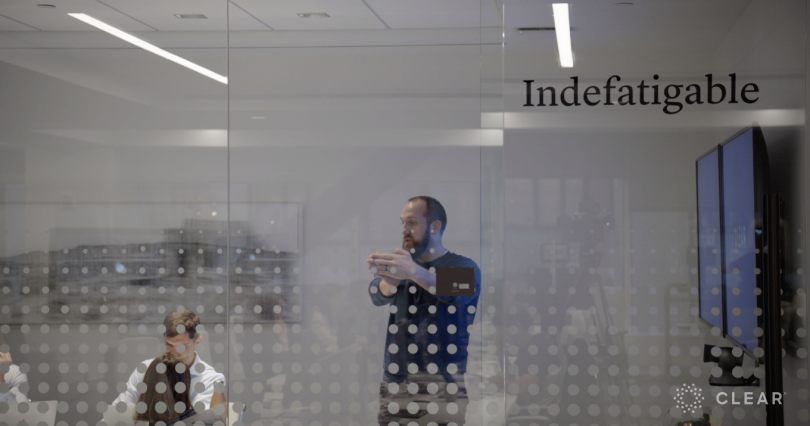In the world of project management, improvements and features added to the original concept are expected. In fact, 52 percent of projects experience scope creep, according to a 2018 survey by the Project Management Institute.
To prevent scope creep, teams must over-communicate, Jeff Soto, technology director at Work & Co, said.
“When scope creep does happen, it’s important that your team and client fully understand feature prioritization,” Soto said. “Strong communication and trust between all project teams and stakeholders help facilitate the balancing act between delivering the best possible product and working within the limitations of timelines, resources and budget.”
Once all stakeholders are aware of a project’s priorities, teams can react to scope creep more effectively and agree on what may slide in and out of scope.
Other tips for managing scope creep include setting clear goals for projects and having trusted processes in place to try out new additions.
“Flexibility is so important in what we do,” Software Engineer Alexander Frankel said. He doesn’t operate under a “no-scope-creep” policy at Common, but rather sets expectations up front so the whole team can work toward the same deadline.
Additional helpful measures? Documentation, strong communication between project teams and stakeholders, and a sense of trust and transparency between directors and engineers.

Soto said the focus at digital agency Work & Co is on building and delivering the best user experiences and for companies through digital design. For example, they launched “Highlights” for Gatorade, an app that lets athletes capture and share their personal sports accomplishments. When working with brands, their model is a more hands-on approach with all parties putting equal time into product life cycles.
What proactive measures does your team take to limit or prevent scope creep, and who are the other stakeholders involved?
Our initial discovery phase on client projects allows us to gain a deeper understanding of our client’s product challenges and opportunities. This is achieved through the research, stakeholder interviews, ideation, prototyping and user testing activities we conduct. Throughout these workstreams, we may uncover a new finding that sparks an interesting idea, which reveals a whole new interaction model. These activities are inherently prone to introducing scope creep, so we take proactive measures to ensure we remain on track and aligned with our project goals.
One of these measures is documentation. Important questions to ask early on include, “Does a newly introduced feature qualify as a project requirement? What challenge does the introduced feature solve and how does it push the overall project goals forward? Are there significant technical implications for the scope change being evaluated?”
Another measure we implement is sandboxing. We try to limit scope creep by conducting sandboxed ideation, concepting and prototyping phases that allow us to explore wildly different approaches where nothing is off the table. Having this dedicated time allows us and our clients to refine the true scope and create a roadmap that focuses on delivering the highest priority features for the product.
Lastly, there is continuous alignment. It’s important to continuously align on project priorities with our teams and clients. We achieve this through weekly client check-ins and daily team stand-ups where we discuss the overall project status, roadblocks and open questions.
It’s important that your team and client fully understand feature prioritization.”
When scope creep does occur, how does your team handle it?
When our projects kick off, we work with our clients to identify the business goals the digital product is meant to achieve and agree upon KPIs. This allows us to examine a given idea or feature against those original goals and KPIs and continuously review and prioritize features with our clients.
If scope creep does happen, it’s important that your team and client fully understand feature prioritization. Strong communication and trust between all project teams and stakeholders help facilitate the balancing act between delivering the best possible product and working within the limitations of timelines, resources and budget. With a strong understanding of priorities, teams are able to react to scope creep more effectively as the feature prioritization process is continuously exercised. By having comprehensive documentation, you will have a clear process that allows you to mutually agree on what may slide in and out of scope as project priorities shift.
What other advice do you have for developers looking to better manage scope creep?
Including your clients in your design or development sprint-planning process will not only provide transparency, but also align expectations. This allows your clients to see the work as it’s being performed and gives them visibility into how the project is tracking. In addition to daily technical stand-ups, having your technical leads participate in the appropriate strategy, design and project management meetings can also be helpful in maintaining visibility into other teams that may impact your scope. If you feel you’re becoming at risk of scope creep, engage your product management team more closely. Together with your product manager, you can build scope consensus amongst your colleagues and key stakeholders.

Frankel is able to keep miscommunication to a minimum with an in-house engineering team at Common. Every project that experiences scope creep can be turned into a learning opportunity. Asking preventive questions like, “Is this feature necessary?” before implementation can save time and money.
What proactive measures does your team take to limit or prevent scope creep?
The engineering team has critical processes in place that automatically limit scope creep up front, and then a secondary follow up to keep our goals on track and catch anything we may have missed. Our biggest tool in preventing scope creep is the upfront work of our project managers that determines initial project requirements with key stakeholders.
Project managers own this from start to finish and establish a clear boundary between stakeholders and engineers. With this structure in place, it frees up my engineering time to code and get into the nitty-gritty of the task at hand, without having to worry about negotiating deadlines or additional requests from others. On the development side, we expect our engineers to be self-aware and able to identify when he or she has veered off course into a mindset of perfectionism instead of focusing on the tasks at hand.
When scope creep does occur, how does your team handle it?
Common’s engineering team is completely in-house, and this allows us to establish requirements and priorities for each individual project with limited miscommunications. When we do notice some scope creep, first we determine if it is justified or unjustified. Flexibility is so important in what we do. It is vital for our team to be able to add in new tasks or objectives to a project when absolutely necessary, but know that it’s not the default. We don’t operate off of a “zero-scope-creep” policy, but attempt to manage expectations upfront.
A challenging task for any development team is deciding whether or not it’s the right time to be adding a new feature or if it’s better to prioritize efficiency in delivering a project. We’ve established trust between our project managers and engineers, which has created an awesome culture of transparency on deadlines and capacity. This means we always know what it takes to meet requirements.
It’s vital to be human in the process of managing scope creep.”
What other advice do you have for developers looking to better manage scope creep?
A maxim from one of our senior developers is, “What’s right versus right now?” As an engineer, I’m constantly asking myself if the additional tasks I want to add to a project are necessary within the timeframe I have.
It’s also vital to be human in the process of managing scope creep. Sometimes, it's rewarding to work on something outside the scope of the project in front of you. Remember that everyone on your team is pushing toward the same goal and trying to get better at their jobs as individuals. It’s in our human nature to be creative and problem-solve. I truly believe creativity and innovation should be recognized and encouraged in the right ways. Managers shouldn’t be afraid to give feedback and make sure the team is aligned on project goals throughout the process. When engineers feel empowered to be creative and thoughtful in their day to day, scope creep becomes much more manageable.

To prevent scope at Clear, an identity platform leveraging biometrics, Software Engineering Lead Val Akkapeddi said he makes sure goals are specific and measurable. Proper planning and the right preventive actions result in clear communication across all teams. There will be changes and opportunities for improvement, but they should be stated and agreed upon before anyone acts on them.
What proactive measures does your team take to limit or prevent scope creep?
We are built around enabling frictionless experiences using biometrics in a variety of different applications such as airport travel, sports and car rentals. As the core team that enables all of this, the biometrics team is directly answerable to many stakeholders, including various business development groups, infrastructure and operations. Given the number of asks and the number of directions from which they originate, scope creep often feels more like an inevitability than a possibility.
We stay ahead of this by articulating clear goals that state upfront the value that each project is trying to capture. Center conversations around minimum requirements to achieve those goals. Ask stakeholders to reevaluate ideas that claim to bring benefits beyond what we wanted to achieve in the first place.
We also make sure that the goals are specific and measurable.
As well, we defend against internal scope creep from the engineering team. This is not to say that technical improvements should not be pursued, but be tactical about addressing tech debt and technical improvement so that your team gains leverage toward better delivering the project goals.
Lastly, set expectations right at the inception of the project about how changes to the committed scope will be addressed. For instance, if one person suddenly gets an idea, they should not run off and divert from the original plan; instead, all stakeholders should achieve consensus on any deviations from the original plan. Program and product management are an excellent mechanism to drive this.
When scope creep does occur, how does your team handle it?
When scope changes, either the resources and capacity to deliver the scope have to change, or we have to scale down our commitment to delivering something else.
To help manage this, I make sure that my team’s commitment is captured in Jira tickets sorted in priority order. If we need to handle scope changes, this makes it easy to identify the lowest priority items to defer to a future sprint. Having a solid relationship with our product team is key to this, because they can help make decisions around the priority. Another thing that helps is having reliable estimates for the amount of effort required to deliver each objective so that you can effectively decide how much of the previously-committed work needs to be deferred.
Ultimately, it all boils down to planning.”
What other advice do you have for developers looking to better manage scope creep?
Ultimately, it all boils down to planning. If you have a project plan that clearly states its objectives and is accurately estimated and prioritized, it is going to be a very resilient plan. You will be able to defend against scope creep that does not add value, and you will be able to absorb any short-term scope changes without compromising the ability to deliver long-term.






